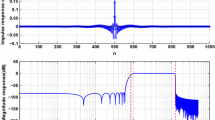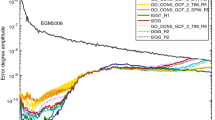Abstract
A regional recovery of the Earth’s gravity field from satellite observables has become particularly important in various geoscience studies in order to better localize stochastic properties of observed data, while allowing the inversion of a large amount of data, collected with a high spatial resolution only over the area of interest. One way of doing this is to use observables, which have a more localized support. As acquired in recent studies related to a regional inversion of the Gravity field and steady-state Ocean Circulation Explorer (GOCE) data, the satellite gravity-gradient observables have a more localized support than the gravity observations. Following this principle, we compare here the performance of the second- and third-order derivatives of the gravitational potential in context of a regional gravity modeling, namely estimating the gravity anomalies. A functional relation between these two types of observables and the gravity anomalies is formulated by means of the extended Stokes’ integral formula (or more explicitly its second- and third-order derivatives) while the inverse solution is carried out by applying a least-squares technique and the ill-posed inverse problem is stabilized by applying Tikhonov’s regularization. Our results reveal that the third-order radial derivatives of the gravitational potential are the most suitable among investigated input data types for a regional gravity recovery, because these observables preserve more information on a higher-frequency part of the gravitational spectrum compared to the vertical gravitational gradients. We also demonstrate that the higher-order horizontal derivatives of the gravitational potential do not necessary improve the results. We explain this by the fact that most of the gravity signal is comprised in its radial component, while the horizontal components are considerably less sensitive to spatial variations of the gravity field.
Similar content being viewed by others
References
Albertella A., Migliaccio F. and Sansó F., 2002. GOCE: The Earth gravity field by space gradiometry. Celest. Mech. Dyn. Astron., 83, 1–15.
Arabelos D. and Tscherning C.C., 1990. Simulation of regional gravity field recovery from satellite gravity gradiometer data using collocation and FFT. Bull. Geod., 64, 363–382.
Arabelos D. and Tscherning C.C., 1993. Regional recovery of the gravity field from SGG and SST/GPS data using collocation. In: Study of the Gravity Field Determination Using Gradiometry and GPS, Phase 1. Final Report. ESA Contract 9877/92/F/FL. ESTEC, European Space Agency, Noordwijk, The Netherlands.
Arabelos D. and Tscherning C.C., 1995. Regional recovery of the gravity field from satellite gravity gradiometer and gravity vector data using collocation. J. Geophys. Res., 100(B11), 22009–22015.
Arabelos D. and Tscherning C.C., 1999. Gravity field recovery from airborne gradiometer data using collaction and taking into account correlated errors. Phys. Chem. Earth A, 24, 19–25.
Ardalan A.A. and Grafarend E.W., 2001. Ellipsoidal geoidal undulations (ellipsoidal Bruns formula): case studies. J. Geodesy, 75, 544–552.
Balakin A.B., Daishev R.A., Murzakhanov Z.G. and Skochilov A.F. 1997. Laser-interferometric detector of the first, second and third derivatives of the potential of the Earth gravitational field. Izvestiya vysshikh uchebnykh zavedenii, seriya Geologiya i Razvedka, 1, 101–107.
Brieden P., Müller J., Flury J. and Heinzel G., 2010. The mission option OPTIMA-novelties and benefit. In: Münch U. and Dransch W. (Eds), Observation of the System Earth from Space. Geotechnologien Science Report 17, Koordinierungsbüro GEOTECHNOLOGIEN, Potsdam, Germany, 134–139.
Bruinsma S.L., Marty J.C., Balmino G., Biancale R., Förste C., Abrikosov O. and Neumeyer H., 2010. GOCE gravity field recovery by means of the direct numerical method. In: Lacoste- Francis H. (Ed.), Proceedings of ESA Living Planet Symposium. ESA SP-686, European Space Agency, Noordwijk, The Netherlands, ISBN 978-92-9221-250-6.
Casotto S. and Fantino E., 2009. Gravitational gradients by tensor analysis with application to spherical coordinates.. J. Geodesy, 83, 621–634.
Du J., Chen C., Lesur V. and Wang L., 2015. Non-singular spherical harmonic expressions of geomagnetic vector and gradient tensor fields in the local north-oriented reference frame. Geosci. Model Dev., 8, 1979–1990.
Eicker A., Mayer-Gürr T. and Ilk K.H., 2005. Global gravity field solutions based on a simulation scenario of GRACE SST data and regional refinements by GOCE SGG observations. In: Jekeli C., Bastos L. and Fernandes J. (Eds), Gravity, Geoid and Space Missions. International Association of Geodesy Symposia, 129, 66–71, Springer-Verlag, Heidelberg, Germany.
Eicker A., Schall J. and Kusche J., 2014a. Regional gravity modelling from spaceborne data: case studies with GOCE. Geophys. J. Int., 196, 1431–1440.
Eicker A., Schall J., Lieb V., Bentel K., Schmidt M., Buße K. and Gerlach C., 2014b. Regional gravity field modeling using radial basis functions: results from IAG’s Joint Study Group JSG0.3 and real data GOCE applications. Geophys. Res. Abs., 16, EGU2014–14275.
European Space Agency, 1999. Gravity Field and Steady-State Ocean Circulation Mission–The Four Candidate Earth Explorer Core Missions. Technical Report, ESA SP-1233(1), European Space Agency Publications Division, Noordwijk, The Netherlands.
Eshagh M., 2008. Non-singular expressions for the vector and the gradient tensor of gravitation in a geocentric spherical frame. Comput. Geosci., 34, 1762–1768.
Eshagh M., 2009. On Satellite Gravity Gradiometry. PhD Thesis. Royal Institute of Technology (KTH), Stockholm, Sweden.
Eshagh M., 2010a. Alternative expressions for gravity gradients in local north-oriented frame and tensor spherical harmonics. Acta Geophys., 58, 215–243.
Eshagh M., 2010b. Least-squares modification of extended Stokes’ formula and its second-order radial derivative for validation of satellite gravity gradiometry data. J. Geodyn., 49, 92–104.
Eshagh M., 2011. The effect of spatial truncation error on integral inversion of satellite gravity gradiometry data. Adv. Space Res., 47, 1238–1247.
Eshagh M. and Romeshkani M., 2011. Generation of vertical-horizontal and horizontal-horizontal gravity gradients using stochastically modified integral estimators. Adv. Space Res., 48, 1341–1358.
Eshagh M. and Romeshkani M., 2013. Quality assessment for terrestrial gravity anomalies by variance component estimation using GOCE gradiometric data and Earth’s gravity models. Stud. Geophys. Geod., 57, 67–83.
Eshagh M. and Ghorbannia M., 2014. The effect of the spatial truncation error on the variance of gravity anomalies derived from inversion of satellite orbital and gradiometric data. Adv. Space Res., 54, 261–271.
Fukushima T., 2012. Numerical computation of spherical harmonics of arbitrary degree and order by extending exponent of floating point numbers. J. Geodesy, 86, 271–285.
Fukushima T., 2013. Recursive computation of oblate spheroidal harmonics of the second kind and their first-, second-, and third-order derivatives. J. Geodesy, 87, 303–309.
Ghobadi-Far K., Sharifi M.A. and Sneeuw N., 2016. 2D Fourier series representation of gravitational functionals in spherical coordinates. J. Geodesy, 90, 871–881, DOI: 10.1007 /s00190-016-0916-7.
Hamáčková E., Šprlák M., Pitoňák M. and Novák P., 2016. Non-singular expressions for the spherical harmonic synthesis of gravitational curvatures in a local north-oriented reference frame. Comput. Geosci., 88, 152–162.
Hansen P.C., 2007. Regularization tools version 4.0 for Matlab 7.3. Numer. Algorithms, 46, 189–194.
Jacoby W. and Smilde P.L., 2009. Gravity Interpretation: Fundamentals and Application of Gravity Inversion and Geological Interpretation. Springer-Verlag, Berlin, Germany.
Janák J., Pitoňák M. and Minarechová Z., 2014. Regional quasigeoid from GOCE and terrestrial measurements. Stud. Geophys. Geod., 58, 626–649.
Keller W. and Sharifi M.A., 2005. Satellite gradiometry using a satellite pair. J. Geodesy, 78, 544–557.
Kotsakis C., 2007. A covariance-adaptive approach for regularized inversion in linear models. Geophys. J. Int., 171, 509–522.
Kotsiaros S. and Olsen N., 2012. The geomagnetic field gradient tensor. GEM-Int. J. Geomath., 3, 297–314.
Kotsiaros S. and Olsen N., 2014. End-to-End simulation study of a full magnetic gradiometry mission. Geophys. J. Int., 196, 100–110.
Krarup T., 1969. A Contribution to the Mathematical Foundation of Physical Geodesy. Meddelelse no. 44, Geodetic Institute, Copenhagen, Denmark.
Krarup T. and Tscherning C.C., 1984. Evaluation of isotropic covariance functions of torsion balance observations. Bull. Geod., 58, 180–192.
Moritz H., 1980. Advanced Physical Geodesy. 1st Edition. Wichmann, Karlsruhe, Germany.
Moritz H., 2000. Geodetic Reference System 1980. J. Geodesy, 74, 128–162, DOI: 10.1007 /S001900050278.
Naeimi M., Flury J. and Brieden P., 2015. On the regularization of regional gravity field solutions in spherical radial base functions. Geophys. J. Int., 202, 1041–1053.
Nagy D., Papp G. and Benedek J., 2000. The gravitational potential and its derivatives for the prism. J. Geodesy, 74, 552–560.
Petrovskaya M.S. and Vershkov A.N., 2010. Construction of spherical harmonic series for the potential derivatives of arbitrary orders in the geocentric Earth-fixed reference frame. J. Geodesy, 84, 165–178.
Pitoňák M., Šprlák M., Hamáčková E. and Novák P., 2016. Regional recovery of the disturbing gravitational potential by inverting satellite gravitational gradients. Geophys. J. Int., 205, 89–98.
Reed G.B., 1973. Application of Kinematical Geodesy for Determining the Short Wave Length Components of the Gravity Field by Satellite Gradiometry. Report No. 201, Department of Geodetic Science, Ohio State University, Columbus, OH.
Romeshkani M., 2011. Validation of GOCE Gravity Gradiometry Data Using Terrestrial Gravity Data. MSc Thesis. KN Toosi University of Technology, Tehran, Iran.
Romeshkani M. and Eshagh M., 2015. Deterministically-modified integral estimators of gravitational tensor. Boletim de Ciências Geodésicas, 21, 189–212.
Rosi G., Cacciapuoti L., Sorrentino F., Menchetti M., Prevedelli M. and Tino G.M. 2015. Measurement of the gravity-field curvature by atom interferometry. Phys. Rev. Lett., 114, 013001.
Rummel R., 1976. A model comparison in least squares collocation. Bull. Geod., 50, 181–192.
Rummel R., Teunissen P. and Van Gelderen M., 1989. Uniquely and overdetermined geodetic boundary value problems by least squares. Bull. Geod., 63, 1–33.
Rummel R., van Gelderen M., Koop R., Schrama E., Sansò F., Brovelli M., Miggliaccio F. and Sacerdote F., 1993. Spherical Harmonic Analysis of Satellite Gradiometry. Publications on Geodesy, 39, Neth. Geod. Comm., Delft, The Netherlands.
Shen Y., Xu P. and Li B., 2012. Bias-corrected regularized solution to inverse ill-posed models. J. Geodesy, 86, 597–608.
Sjöberg L.E., 2003. A general model for modifying Stokes’ formula and its least-squares solution. J. Geodesy, 77, 459–464.
Šprlák M. and Novák P., 2015. Integral formulas for computing a third-order gravitational tensor from volumetric mass density, disturbing gravitational potential, gravity anomaly and gravity disturbance. J. Geodesy, 89, 141–157.
Šprlák M., Novák P. and Pitoňák M., 2016. Spherical harmonic analysis of gravitational curvatures and implications for future satellite mission. Surv. Geophys., 37, 681–700.
Šprlák M. and Novák P., 2016. Spherical gravitational curvature boundary-value problem. J. Geodesy, 90, 727–739, DOI: 10.1007/s00190-016-0905-x.
Tikhonov A.N. and Arsenin V.Y., 1977. Solutions of Ill-Posed Problems. Winston and Sons, Washington, D.C.
Tscherning C.C., 1988. A study of satellite altitude influence on the sensitivity of gravity gradiometer measurements. DGK Reihe B, 287, 218–223.
Tscherning C.C., 1989. A local study of the influence of sampling rate, number of observed components and instrument noise on 1 deg. mean geoid and gravity anomalies determined from satellite gravity gradiometer measurements. Ric. Geod. Topogr. Fotogram., 5, 139–146.
Tscherning C.C., Forsberg R. and Vermeer M., 1990. Methods for the Regional Gravity Field Modelling from SST and SGG Data. Reports of the Finnish Geodetic Institute, Helsinki, Finland.
Tscherning C.C. and Herceg M., 2015. Using ground gravity to improve ice mass change estimation from GOCE gravity gradients in mid-west Greenland. Stud. Geophys. Geod., 60, 56–68.
Visser P.N.A.M., 1992. The Use of Satellites in Gravity Field Determination and Model Adjustment. Delft University Press, Delft, The Netherlands.
Wolf K.I., 2007. Kombination globaler Potentialmodelle mit terrestrischen Schweredaten für die Berechnung der zweiten Ableitungen des Gravitationspotentials in Satellitenbahnhöhe. Wissenschaftliche Arbeiten der Fachrichtung Geodäsie und Geoinformatik der Leibniz Universität Hannover, Hannover, Germany (in German).
Xu P., 1992. Determination of surface gravity anomalies using gradiometric observables. Geophys. J. Int., 110, 321–332.
Xu P., 1998. Truncated SVD methods for discrete linear ill-posed problems. Geophys. J. Int.,, 505–514.
Xu P., 2009. Iterative generalized cross-validation for fusing heteroscedastic data of inverse illposed problems. Geophys. J. Int.,, 182–200.
Xu P., Shen Y. Fukuda Y. and Liu Y., 2006. Variance component estimation in linear inverse illposed models. J. Geodesy,, 69–81.
Yildiz H., 2012. A study of regional gravity field recovery from GOCE vertical gravity gradient data in the Auvergne test area using collocation. Stud. Geophys. Geod.,, 171–184.
Zielinski J.B., 1975. Solution of the downward continuation problem by collocation. Bull. Geod.,, 267–277.
Author information
Authors and Affiliations
Corresponding author
Rights and permissions
About this article
Cite this article
Sharifi, M.A., Romeshkani, M. & Tenzer, R. On inversion of the second- and third-order gravitational tensors by Stokes’ integral formula for a regional gravity recovery. Stud Geophys Geod 61, 453–468 (2017). https://doi.org/10.1007/s11200-016-0831-7
Received:
Revised:
Accepted:
Published:
Issue Date:
DOI: https://doi.org/10.1007/s11200-016-0831-7




